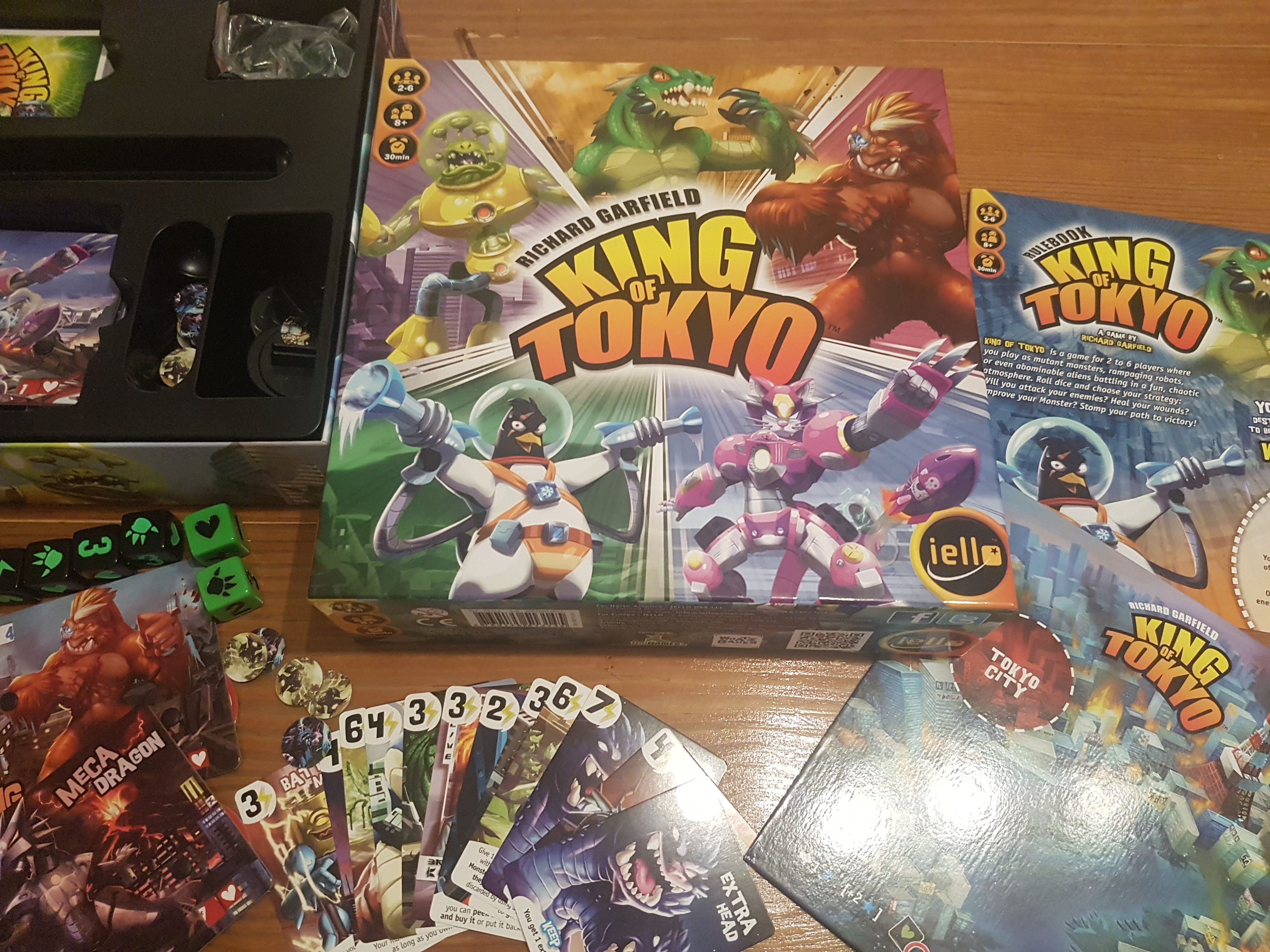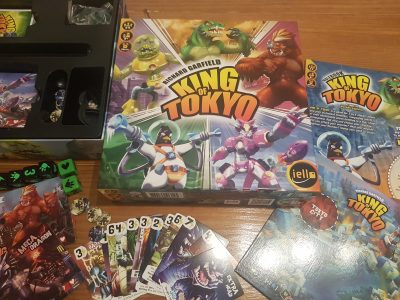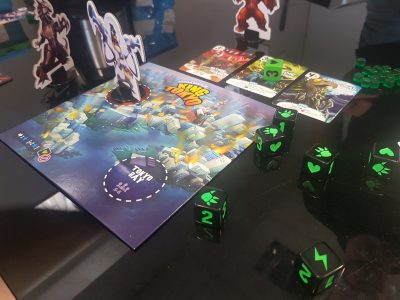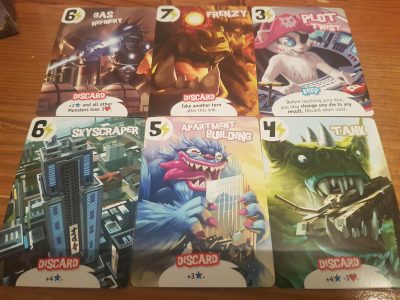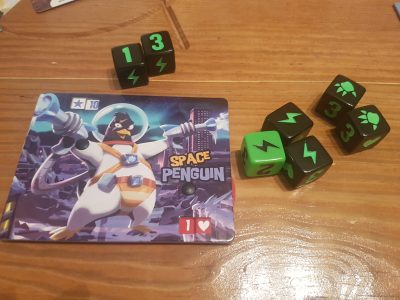Released back in 2011, King of Tokyo has become one of the top gateway games to introduce new players to the hobby. Within 30 minutes 2 – 6 players can have rolled dice and witnessed mighty monsters fight it out for victory, within the city of Tokyo. Fit to play with family and friends alike, King of Tokyo is easy to get to the table, but what is the game itself like?
King of Tokyo doesn’t try to be something it’s not. At its core, it is a light Yahtzee-like dice rolling game with the addition of Power Cards that add various abilities into the mix. On each dice are three numbers, 1, 2 and 3, and three symbols, Smash, Heal and Energy. Rolling a set of three identical numbers nets a player that number of victory points. For example, three 2’s scores the player 2 victory points. After rolling, the number of dice showing Energy is the number of energy cubes they can collect. Heal, unsurprisingly, allows the player to regain health, unless they are in Tokyo city, with the maximum number of hit points being twelve.
Finally, Smash sees these colossal monsters dish out some damage. When in the city of Tokyo each Smash rolled deals one point of damage to every other player takes. When outside of Tokyo city damage is dealt to only the monster currently inside the city. When damage of any amount is dealt to the monster inside of Tokyo city that player can decide whether to remain their or to retreat from the city. Retreating forces the player inflicting the damage into the city. On a default players turn 6 dice are rolled. Players have the option, after an initial roll, for two re-rolls. After this their dice take effect. This helps players alleviate part of the luck and random element of dice rolling but maintains the dice based tension.
Risk and reward is a big part of King of Tokyo. Past the odds and probability side of rolling dice the best example is the mechanic of staying or leaving the city of Tokyo. If a player survives everyone else’s turns and their monster’s standees still sits triumphantly in the city they earn a single victory point. Attempting to do this however could be a bit of a risk because of the incoming damage from other players. It’s best to go in when on high health and look to deal a significant amount of damage to others. This way other players must concentrate on healing instead of obtaining victory points or risk being killed off. Alas, the balancing of the city sees you become the target of all other players attacks and it can feel like all against one if you push your luck too much. Especially as you’re unable to heal up.
What steps the game up and away from a reskinned Yahtzee is the Power Cards. Power cards range from mitigating damage to giving bonus damage every time you attack from within Tokyo. Some even let players come back into the game after falling to 0 health or provide additional turns. Not every power card comes with a crazy ability, some offer more simple trades for victory points, but each is balanced by appropriate energy costs. Intuitively, the bigger and better the ability the costlier the power card is to claim. This isn’t to say the low-cost cards are useless. Often combinations of cards allowing players to sponge damage on one turn but deal out extra on another is what swings the game. The feature of keep and discard on these power cards furthers the balance of the card abilities, changing otherwise game breaking cards into an acceptable one shot ability.
Abilities can completely change the way a game is played adding much needed variation to the game. For instance, if a card offers the ability to have a second turn by rolling a set of three 1’s that player will potentially be re-rolling Smash, Heal and Energy symbols in an attempt to go again. Given the odds side of the game this can see players screaming at the dice when missing out on the combination they were after didn’t happen. At other times players may be maximising Energy rolls as they have a Power card which enables them to spend Energy to block incoming damage. This leads to an interesting dynamic of what is “best” to roll, something which changes from game to game.
The cartoony, over the top illustrations of the monsters, and on the power cards, help highlight the light-hearted nature of King of Tokyo. Never before have I seen a colossal Cyber Kitten attempt to dish out damage to a Meca-Dragon, or a huge Space Penguin for that matter. The fun aspect of the game is thrust forward, not taking itself too seriously and this perfectly matches the lighter gameplay on offer.
Continuing the lighter nature of King of Tokyo there is some light strategy that can be utilized. This only extends to trading off between going straight for points, dishing out tonnes of damage or acquiring energy to spend on the face up cards. No one route has an advantage but each offers a slightly different feel. Going for points or damage will most likely be going for a short, quick game before others can obtain decent cards via energy. It adds some slight player decision and a sense of which to aim dice-wise. Nevertheless, players are still somewhat slaves to their dice rolls.
Unlike the recently released Gekido: Bot Battles, King of Tokyo utilizes standees for the monsters players control. It makes sense to do this to keep the cost down for players, with King of Tokyo being a great gateway game. Thus, the price point shouldn’t put many new players off. Full on miniatures just aren’t needed: especially as it’s a chance to get the over the top illustrations onto player pieces. The standees are mostly just used so players know whom is in the city of Tokyo, in the bay or neither. Despite limited movement and contact with them it is nice to see that they are made from solid enough card so that they will last for a long time. There’s nothing worse than when even lightly used pieces start to pick up marks and scuffs.
King of Tokyo offers a light gameplay experience that means families can enjoy it but is entertaining enough that those regularly gaming engaged. Simplicity is the game’s biggest strength as you can teach the game within minutes and get straight to the action. Past being an entry point into the wonderful world of modern board games, King of Tokyo could be classed as a filler board game. This shouldn’t be thought of as detrimental though as everyone needs a light, fun and refreshing game to play between huge large weighty board games. The over the top nature of the art work and theming cascade down to the players whom will be cheering and screaming at the dice as they die or decimate opponents. King of Tokyo is an instant hit as soon as it gets to the table and that is why it is a board gaming essential!
[Editor’s Note: King of Tokyo was provided to us by Esdevium Games for review purposes. The game is currently available from 365 Games for £21.99]

